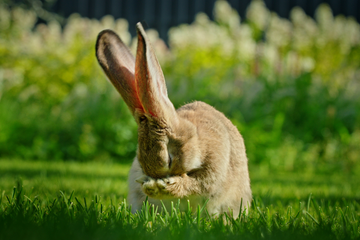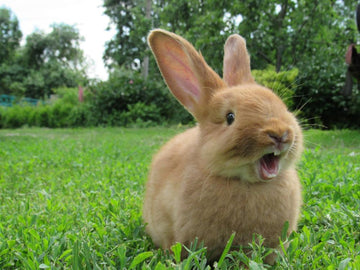Decoding Bunny Behavior: Understanding Rabbit Mood
If your rabbit has been stomping their back foot like they're throwing a tiny tantrum, don't panic. That thump is their version of shouting, and while it can sound like a dramatic protest, it's usually their way of saying, "Something's not right."
Click Here For a Beginners Guide to Rabbit Care.

Rabbits thump for many reasons, often triggered by fear, confusion, or discomfort. Learning what your rabbit is trying to tell you when they act this way is important. Once you understand their triggers, you can create a calm and trusting environment for them.
Understanding rabbit mood is the first step toward a peaceful relationship with your bun—and a quieter house.

What Is Rabbit Thumping?
Thumping is when a rabbit stomps its back foot forcefully on the ground. It can be loud and sudden, especially on hard flooring. In the wild, this action alerts other rabbits to danger. It's an instinctive behavior passed down from generations of rabbits that needed to warn their warren.
While domestic rabbits don't have predators lurking behind every corner, they still rely on thumping to communicate fear or frustration. It's a strong emotional signal, not something to ignore. Think of it like a built-in alarm system that says, "Pay attention!"
Common Reasons Rabbits Thump
Your rabbit isn't just trying to get attention. They're reacting to something they see, hear, or feel as a threat. Sometimes, that "threat" is just something new or confusing in their space.
They saw a shadow moving nearby and couldn't identify the source.
They smelled smoke—whether from burnt toast, wildfire smoke outside, or a candle being blown out.
They spotted another animal, like a cat or dog, even through a window.
They're unsure of a new human or haven't fully bonded with you yet.
These are just a few examples, but they all lead back to a similar emotional root: fear. Thumping is your rabbit's way of saying, "I don't feel safe." It may not mean something is truly dangerous, but it means your rabbit believes it is.
That's why understanding rabbit mood matters so much. If you can figure out what's behind that foot stomp, you can start to fix it.
Understanding Rabbit Mood Through Body Language
Thumping isn't the only mood indicator your rabbit gives. Their body language tells a full story if you know how to read it. Rabbits are quiet communicators, and subtle shifts in their behavior reveal how they feel.
Is your rabbit crouched low with ears flattened? They're probably scared or feeling threatened. Are their ears up and forward while they explore the room? That shows curiosity and confidence. If they're hunched in a corner and ignoring food, something's wrong—maybe emotionally, maybe physically.
Even thumping has layers. A single stomp may signal surprise, while repeated thumps could mean a full-blown alarm. If they're thumping while staring at you, they may be frustrated or upset with something you did.
Learning to read these cues builds trust. The more you understand their nonverbal language, the more they'll feel seen—and safe—with you.
Check for Health Issues First
If your rabbit's behavior has changed suddenly or they're acting more aggressive, don't assume it's just moodiness. Rabbits are masters at hiding pain or illness, and behavioral shifts are often the only clue you'll get.
Loss of appetite, changes in bathroom habits, or staying hunched in one spot are red flags. So is biting, lunging, or excessive thumping, especially if it's a new behavior. If your rabbit lets out a high-pitched scream—a rare but unmistakable sound—they need help immediately.
A trip to the vet should be your first move if you suspect anything's off. You can focus on behavioral solutions once you've ruled out medical issues. But never skip this step. Pain can make even the gentlest rabbit act out.
Spaying and Neutering Changes Everything
Once your rabbit is physically healthy, it's time to look at their hormones. If your rabbit hasn't been spayed or neutered, this could be the root of their aggression or mood swings.
Unfixed rabbits tend to be more territorial, especially females. Hormones can turn a sweet bunny into a defensive one almost overnight. You might notice more thumping, nipping, or cage aggression. These aren't bad behaviors—they're biologically driven instincts.
Spaying or neutering your rabbit helps settle these hormonal urges and usually leads to a calmer, more even-tempered rabbit. It also prevents serious health problems down the line, including reproductive cancers.
Breeding is not a solution to calm your rabbit's mood. While some believe that letting a female have a litter will "balance her out," it's a temporary fix that comes with serious responsibility—and more bunnies.
If you're unsure where to start, we've broken down the spay and neuter process right here.
Understanding Learned Behavior and Rabbit Mood
If your rabbit has been spayed or neutered and checked out healthy, but they're still thumping or showing aggression, you're likely dealing with learned behavior. Rabbits remember scary or unpleasant experiences and can form habits based on those memories.
This might mean they thump whenever a certain door slams or someone walks past their enclosure wearing shoes. These triggers may seem minor to us, but to your rabbit, they're significant enough to cause anxiety.
Understanding rabbit mood in these moments involves identifying patterns. Watch what happens right before the thumping starts. Are you reaching into their space without warning? Is there a new pet or baby in the house? Is your rabbit housed in a high-traffic area where surprises are common?
Once you've identified the source, you can start desensitizing your rabbit. That doesn't mean forcing them to tolerate it—it means making it feel safe, predictable, and unthreatening.
How to Help Your Rabbit Feel Safe
Rabbits thrive on consistency. Sudden changes in their environment or routine can make them nervous and trigger thumping. Here are a few things you can do to help your rabbit feel more secure:
Place their habitat in a quiet area. Avoid busy walkways, loud electronics, or rooms with unpredictable noise.
Approach slowly and at their level. Sudden movements or towering over them can feel like a predator is approaching.
Offer routine and structure. Feed them at consistent times and keep their space organized. Even cleaning their cage should follow a predictable rhythm.
These small adjustments make a big difference. When your rabbit knows what to expect, they'll relax—and that mood shift will show in less thumping and more calm behavior.

Gentle Bonding Techniques to Build Trust
Bonding with a fearful or aggressive rabbit takes time and patience. You can't force trust—it has to grow naturally. But there are plenty of methods that can help your rabbit associate you with positive feelings.
Start by sitting near their enclosure without interacting. Just let them observe you from a safe distance. Over time, offer treats from your hand or drop them near your feet so your rabbit chooses the approach. Let them come to you, not the other way around.
One effective tool for this process is the TTouch method. Originally developed for dogs and horses, this technique uses gentle, circular touches to create a calming connection. It's been adapted for rabbits and can help build comfort during handling.
Another option is scent introduction. Take a soft cloth or an old T-shirt you've worn and place it in their space. Add a small treat nearby to encourage investigation. This helps your rabbit get used to your scent and see it as safe.
Still not seeing progress? It may be time to explore tips from a rabbit behaviorist. The team at The Rabbit House shares useful techniques for working with aggressive or fearful rabbits.
Don’t Punish—Redirect
One of the most important things to remember about rabbit behavior: never punish them. Yelling, tapping the cage, or trying to correct a rabbit's behavior physically will only increase their fear and damage your bond.
If they thump, pause and look around. What are they responding to? Remove or adjust the trigger if possible. Then, offer reassurance in a calm voice or give them space if needed. Rabbits need to feel in control of their space to feel safe in it.
When they do show curiosity, relaxation, or affection—reward it! Positive reinforcement is the key to rewiring their emotional responses. The goal isn't obedience; it's trust.
Give Them the Right Tools for Comfort
Part of managing rabbit mood includes making sure they have what they need to feel safe and content in their environment. This includes both emotional security and physical comfort.
A well-designed habitat is essential. Your rabbit needs room to stretch, hide, dig, and play. Provide hideouts like tunnels or covered boxes where they can retreat when anxious. Make sure their flooring is soft, and their litter box is kept clean.
Diet also plays a surprising role in mood. Rabbits not getting enough fiber can become cranky, uncomfortable, and even aggressive. Their digestive systems are delicate, and discomfort often leads to behavioral changes. That's why 80% of your rabbit's diet should be made up of high-quality grass hay.
We only carry hay that meets that standard. If you're not sure which type is best, we break it all down in our Hay 101 Blog. A happy belly makes for a happier bun.
When Thumping Is Just... Personality
Sometimes, your rabbit has a big personality—and thumping is part of it. Some buns are naturally more expressive, vocal, or sensitive than others. It doesn't mean something is wrong. It just means you've got a rabbit who likes to have opinions.
If all the health, hormonal, and environmental boxes have been checked, and your rabbit is still thumping now and then, it may be their way of keeping you on your toes. Consider it part of their charm.
Keep showing them consistency, love, and respect for their space. Over time, the bond will deepen—and the mood swings will usually level out.
Final Thoughts on Understanding Rabbit Mood
Rabbits are complex, sensitive creatures. While thumping can seem like a tantrum, it's really a communication tool—and a clear window into their emotional state. By learning the signs, understanding rabbit mood becomes a powerful part of your relationship.
Whether it's fear, frustration, or flair, your bun is trying to talk to you. When you listen and respond with care, the rewards are endless: deeper trust, better behavior, and a much happier rabbit.
Want more rabbit care advice? Check out our guide to starting off right with your rabbit.
And don't forget—Rabbit Hole Hay carries only the freshest, premium hay to keep your rabbit's diet (and mood) right where it should be. A happy bun starts with a healthy belly.
Key Takeaways
Rabbit thumping is a natural behavior rooted in fear or warning—it's not just a mood swing.
Understanding rabbit mood involves recognizing body language, habits, and environmental triggers.
Health issues, hormones, or past experiences can all contribute to behavioral changes. Always start with a vet check and spay/neuter.
Trust takes time. Use positive reinforcement, calm energy, and safe environments to build a strong bond with your rabbit.

"Why Is My Rabbit Licking Her Own Pee?"

Rabbit Is It Low Maintenance or More Work Than You Think?

Tips to Manage Rabbit Chewing Habits










